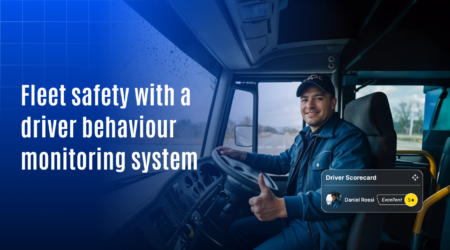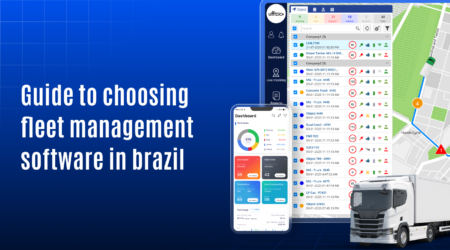8 Common Mistakes with GPS Tracking Software in Brazil
Brazil is embracing GPS tracking technology at a rapid pace. From logistics firms in São Paulo to delivery fleets in Recife, businesses across the country are turning to GPS software to optimize their operations.
But here’s the catch. Many companies in Brazil invest in GPS tracking software, only to use it incorrectly or underutilize its full potential. This leads to wasted investment, missed insights, and poor results.
In this blog, we’ll explore eight common mistakes Brazilian businesses make with GPS tracking software, and how you can avoid them. Whether you’re a fleet owner, logistics provider, or system integrator, this guide will help you get more value out of your GPS solution.
Choosing the Cheapest Software, Not the Right One
Mistake:
Many businesses in Brazil opt for the most affordable GPS solution. While budget is important, this often results in software that lacks essential features or isn’t reliable.
Why it’s a problem:
- Limited features can’t support long-term growth.
- Frequent breakdowns or data loss create operational issues.
- Poor support from low-cost providers.
Solution:
- Look for a GPS platform with proven uptime, customization options, and responsive support.
- Request a demo and test it against real use cases.
- Evaluate long-term ROI, not just initial cost.
Ignoring Local Compliance Requirements
Mistake:
Brazil has specific regulations related to vehicle tracking, especially in industries like school transport, logistics, and public safety. Many users don’t check if their software meets ANTT or DENATRAN standards.
Why it’s a problem:
- Non-compliance can lead to penalties or disqualification from tenders.
- GPS data might not align with legal reporting formats.
Solution:
- Choose software that supports Brazilian fleet regulations.
- Ask for features like automated compliance reports, GPS data exports, and audit logs.
- Confirm that the provider stays updated with new rules.
Stay compliant with Brazil’s fleet laws. [Schedule a compliance-ready demo.]
Not Customizing the Software for Local Routes and Traffic
Mistake:
Out-of-the-box GPS tools often use global maps and settings that don’t reflect the local challenges of Brazil’s road network.
Why it’s a problem:
- Traffic in cities like Rio de Janeiro or Belo Horizonte can change drastically.
- Routes through favelas or remote areas need special attention.
- Toll roads and regional delivery norms vary widely.
Solution:
- Use software that allows regional route optimization.
- Integrate real-time traffic and local map overlays.
- Configure settings to reflect Brazilian driving conditions.
Underusing Alerts and Automation Features
Mistake:
Some users only use GPS to “see location” and ignore advanced features like alerts, geofences, or automated reports.
Why it’s a problem:
- Managers spend more time manually tracking data.
- Delayed response to speeding, idling, or route deviations.
- Missed opportunities to improve safety and fuel usage.
Solution:
- Set up real-time alerts for overspeeding, stoppages, and unauthorized routes.
- Use automation to receive daily, weekly, or custom reports.
- Train your staff to manage and act on alerts effectively.
Failing to Train Drivers and Fleet Staff
Mistake:
Even with advanced GPS tools, if your team doesn’t understand how to use the system, it won’t help.
Why it’s a problem:
- Drivers may ignore alerts or misuse the vehicle.
- Fleet managers underreport issues or delay actions.
- Adoption rates stay low.
Solution:
- Provide hands-on training sessions for both drivers and staff.
- Share success stories to show the benefits.
- Make GPS tracking part of daily operational routines.
Not Using the Mobile App
Mistake:
Many GPS platforms offer mobile apps, but users in Brazil often rely only on desktop versions.
Why it’s a problem:
- Field supervisors can’t monitor vehicles on the move.
- You lose flexibility in decision-making.
- Delays in responding to real-time issues.
Solution:
- Encourage all supervisors to install and use the mobile app.
- Use the app for live location, alert acknowledgment, and driver communication.
- Ensure mobile accessibility for route planning and last-mile tracking.
Ignoring Maintenance and Fuel Insights
Mistake:
GPS systems today provide much more than location. Yet, users often skip integrating maintenance reminders and fuel sensors.
Why it’s a problem:
- Missed maintenance leads to vehicle breakdowns.
- Fuel theft or wastage goes unnoticed.
- Operational costs rise.
Solution:
- Enable features like engine health tracking and fuel level monitoring.
- Get automated alerts for service dates or low fuel.
- Use data to optimize route planning and vehicle load.
Not Evaluating Software Performance Regularly
Mistake:
After installation, many companies forget to audit the software’s performance or check if it still meets their evolving needs.
Why it’s a problem:
- Outdated settings reduce tracking accuracy.
- Missed opportunities for upgrades or integration.
- Your business outgrows the software.
Solution:
- Review system performance quarterly.
- Ask your provider about new features or modules.
- Upgrade plans based on your current business size and goals.
Summary: Learn and Improve Before It’s Too Late
GPS tracking software is a powerful tool for any Brazilian business managing vehicles. But just buying it isn’t enough. You must use it smartly, align it with local needs, and continually optimize how it’s applied in day-to-day operations.
Let’s quickly recap the top mistakes to avoid:
- Choosing price over performance.
- Missing out on local compliance settings.
- Ignoring route and map localization.
- Skipping advanced features like alerts and automation.
- Lack of staff training.
- Not using the mobile app.
- Overlooking fuel and maintenance features.
- Failing to evaluate system performance.
Avoid these errors, and you’ll not only save costs but also improve productivity, safety, and compliance.


